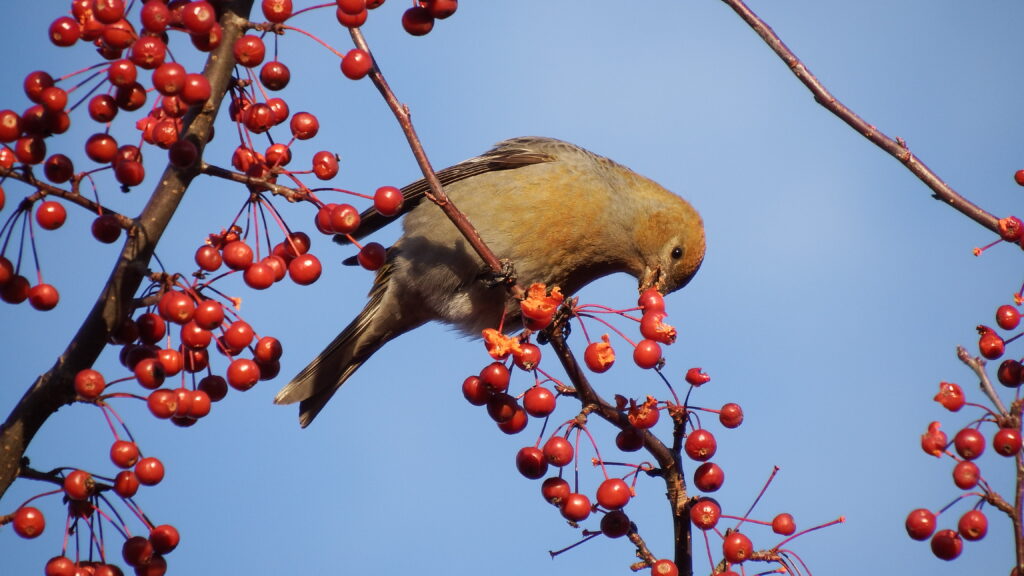
There’s a finch explosion in Aroostook County this winter
By Bob Duchesne
My wife, Sandi, and I had hoped to be in Florida with friends this week. Then came omicron. We thought better of it. Instead, we’ve been spending our planned vacation time right here at home, with motel stays in Greenville, Jackman and Portage so far.
I’ve noted previously that we are volunteers for the Maine Department of Inland Fisheries and Wildlife, surveying for the Maine Bird Atlas. The five-year project is mapping birds throughout the state, in both summer and winter, creating a baseline of information that can be used to track environmental changes over time.
Sandi is the regional coordinator for the Jackman region. I coordinate the Greenville region. We also pitch in as best we can in other regions.

PINE GROSBEAK – A pine grosbeak nibbles on some berries. It’s one of the many birds that can be seen in northern Maine during the winter months.
Aroostook County needs pitching-in. Surveys in populated areas are going well, but almost nobody goes birding in the North Woods. Fortunately, we do.
The entire northwest corner of the state was virtually untouched until we walked miles of the Realty Road last weekend, reaching halfway from Ashland to Clayton Lake. It was 10 degrees below zero when we started walking on Sunday morning. Welcome to Aroostook County.
Happily, there was no wind, we were wearing everything in the closet, and the birds seemed impervious to the cold. They gathered in huge, noisy flocks and kept us entertained all morning. By 11 a.m., it had warmed to minus 5 degrees. I was so toasty, I had to remove one sweater.
There’s a finch explosion going on across northern Maine this winter. The woods are full of common redpolls, pine siskins, pine grosbeaks and white-winged crossbills, most coming down from Canada. Evening grosbeaks and red crossbills are present in smaller numbers. Oddly, most of the winter finch irruption has remained north of Bangor. More on that coming soon.
What made this trip especially nice was that most Maine birders, including me, don’t get to experience Aroostook County nearly as much as we should. Its immense forest and higher latitude lure a different mix of birds, favoring species that are more commonly found in Canada. Even the agricultural areas entice birds that might normally call Quebec home.
But never mind all that. Aroostook County just feels different — fun. We spent two nights at Dean’s Motor Lodge in Portage. They do a big business with snowmobilers, no surprise in a county where winter lasts 11 months. I don’t own a sled myself, but the revving of an engine just sounds like home to me.
Poutine was on the restaurant menu. The Canadian Broadcast Corp. was on cable. We watched the Olympics from a Canadian perspective — cheering for the athletes wearing a maple leaf. Gas was 20 cents higher. Internet was 20 percent slower. You could drive the entire county, and never see a Volvo.
Paper mills have had a rough time in Maine over the last few years, but sawmills are humming right along. Despite a big dump of snow, the logging roads were well-plowed and driving was easy. The walking was even easier.
Sandi and I did, of course, raise some eyebrows. We’ve walked logging roads all over the Jackman, Kokadjo and Ashland areas this winter, and one thing is universally true: nobody expects pedestrians that deep in the woods. “Are you OK?” is how most conversations start.
If anyone wants to try this, anywhere across northwestern Maine, I do have some advice. Stick to the main roads. There’s no need to go down narrower side roads, where it’s harder to pull off for logging trucks coming the other way.
The finch explosion is best viewed along major logging routes, where birds find enough grit to help grind and digest their seed-and-weed winter diet. The birds also relish the salt they find in clumps of snow that have fallen off the undercarriage of vehicles. In fact, this tendency of birds to congregate on the road, first thing in the morning, means that walking isn’t necessary if you’re not a cold-weather hiking fan. Just watch for flocks in the road.
Other obvious tips: Fill the gas tank. Stop for logging trucks in both directions. Avoid parking around blind corners. Watch out for soft, snow-covered ditches when you pull off the road.
Also, if this column inspires you to plan your own north woods birding trip this winter, please check out MaineBirdAtlas.gov to see how your observations can benefit Maine’s entire birding community.